Global Health Report: Sustainability Around Hepatitis E Vaccine
VerifiedAdded on 2020/01/06
|21
|8007
|22
Report
AI Summary
This report provides a comprehensive overview of Hepatitis E, a global health concern, examining its history, prevalence, and impact. It delves into the reasons for interventions, particularly focusing on the sustainability of vaccines and the challenges associated with their implementation. The report highlights the science behind Hepatitis E vaccines, including their development and efficacy, while also addressing the critical aspects of delivering information to target audiences for effective health promotion. It explores issues around sustainability and resilience, such as socio-economic factors, government stability, and environmental impacts, which can hinder prevention and intervention efforts. The report emphasizes the importance of sanitation, hygiene, and vaccination in controlling the spread of Hepatitis E and minimizing its impact on public health. The study also includes tables that show the origination of HEV and geographical distribution pattern.
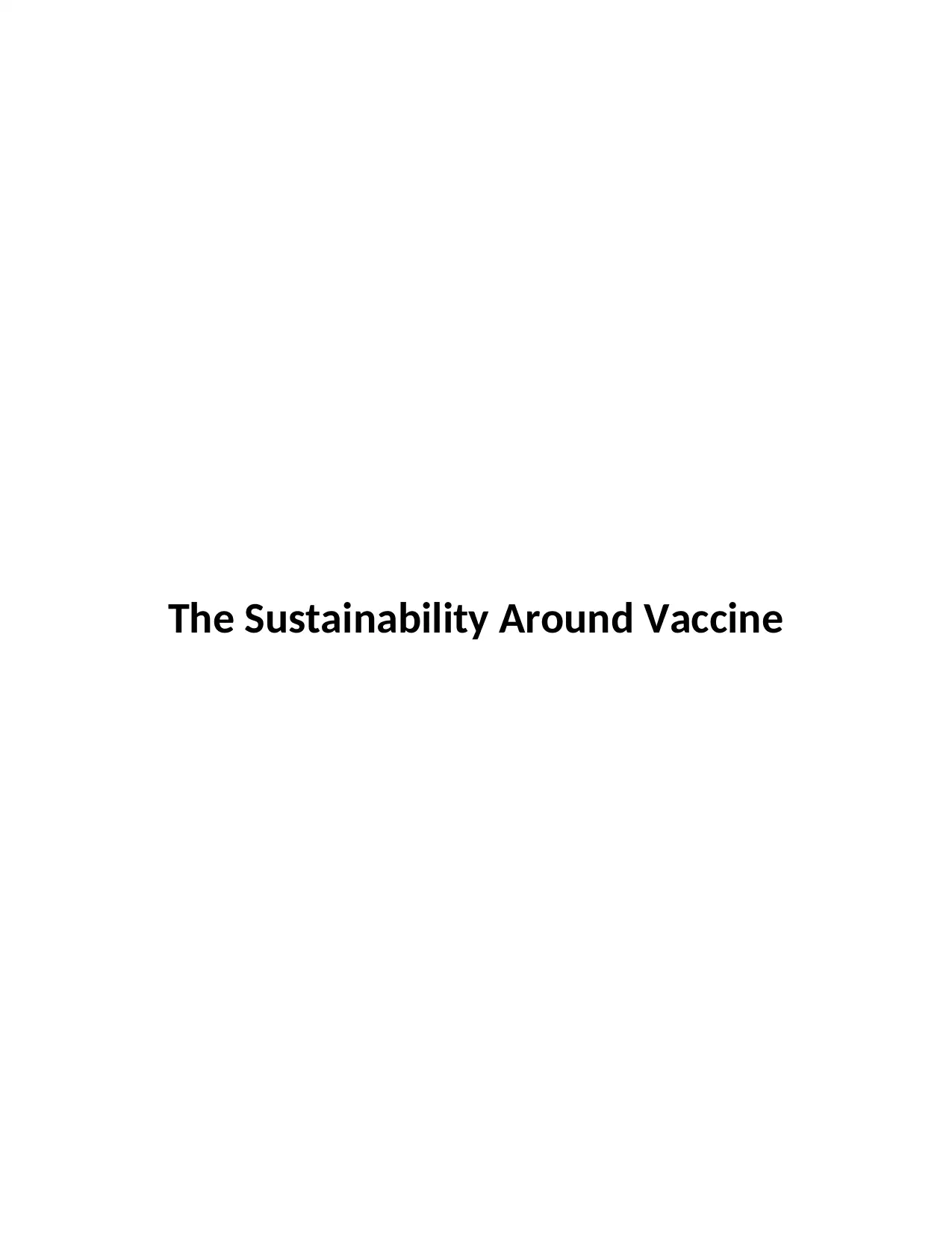
The Sustainability Around Vaccine
Paraphrase This Document
Need a fresh take? Get an instant paraphrase of this document with our AI Paraphraser
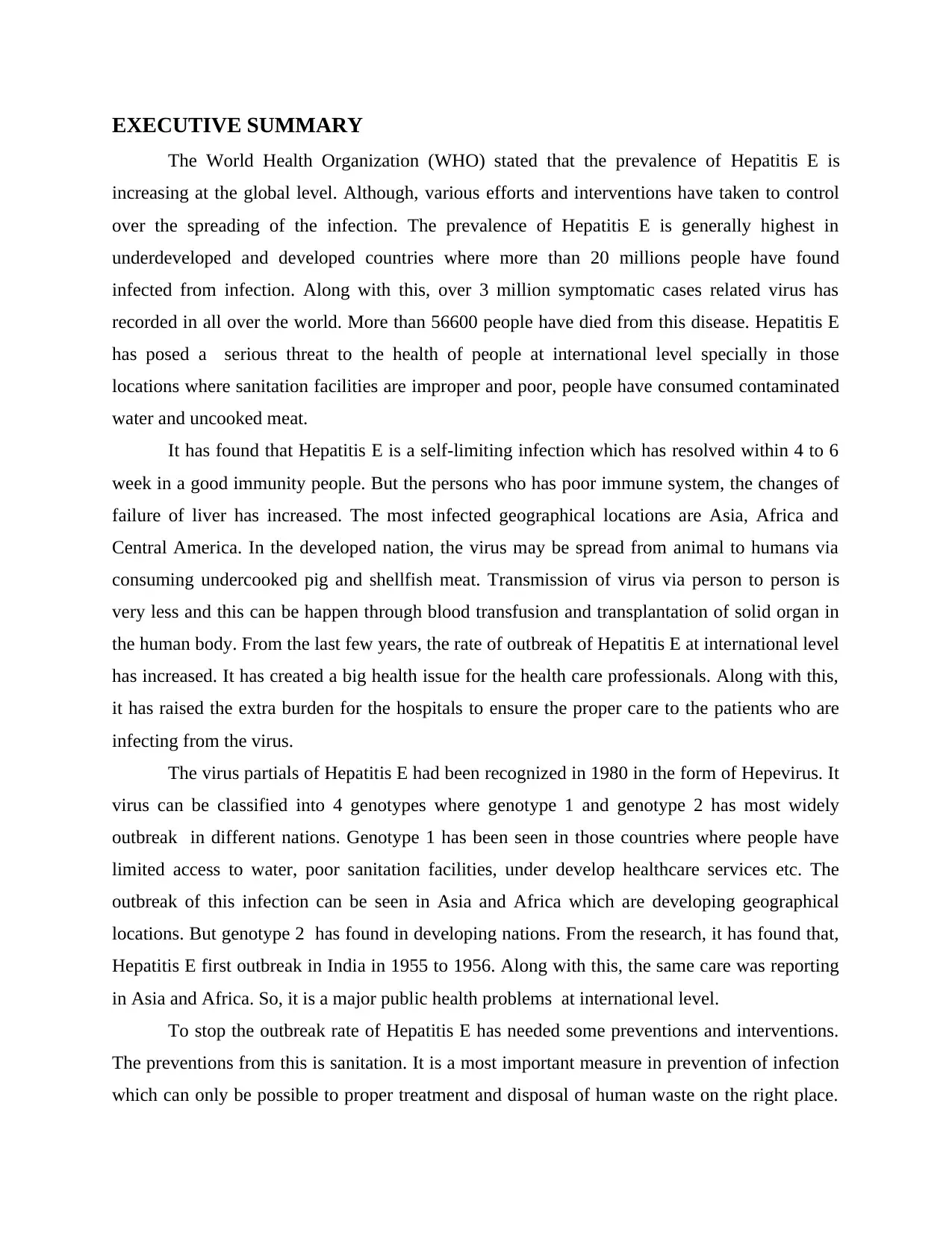
EXECUTIVE SUMMARY
The World Health Organization (WHO) stated that the prevalence of Hepatitis E is
increasing at the global level. Although, various efforts and interventions have taken to control
over the spreading of the infection. The prevalence of Hepatitis E is generally highest in
underdeveloped and developed countries where more than 20 millions people have found
infected from infection. Along with this, over 3 million symptomatic cases related virus has
recorded in all over the world. More than 56600 people have died from this disease. Hepatitis E
has posed a serious threat to the health of people at international level specially in those
locations where sanitation facilities are improper and poor, people have consumed contaminated
water and uncooked meat.
It has found that Hepatitis E is a self-limiting infection which has resolved within 4 to 6
week in a good immunity people. But the persons who has poor immune system, the changes of
failure of liver has increased. The most infected geographical locations are Asia, Africa and
Central America. In the developed nation, the virus may be spread from animal to humans via
consuming undercooked pig and shellfish meat. Transmission of virus via person to person is
very less and this can be happen through blood transfusion and transplantation of solid organ in
the human body. From the last few years, the rate of outbreak of Hepatitis E at international level
has increased. It has created a big health issue for the health care professionals. Along with this,
it has raised the extra burden for the hospitals to ensure the proper care to the patients who are
infecting from the virus.
The virus partials of Hepatitis E had been recognized in 1980 in the form of Hepevirus. It
virus can be classified into 4 genotypes where genotype 1 and genotype 2 has most widely
outbreak in different nations. Genotype 1 has been seen in those countries where people have
limited access to water, poor sanitation facilities, under develop healthcare services etc. The
outbreak of this infection can be seen in Asia and Africa which are developing geographical
locations. But genotype 2 has found in developing nations. From the research, it has found that,
Hepatitis E first outbreak in India in 1955 to 1956. Along with this, the same care was reporting
in Asia and Africa. So, it is a major public health problems at international level.
To stop the outbreak rate of Hepatitis E has needed some preventions and interventions.
The preventions from this is sanitation. It is a most important measure in prevention of infection
which can only be possible to proper treatment and disposal of human waste on the right place.
The World Health Organization (WHO) stated that the prevalence of Hepatitis E is
increasing at the global level. Although, various efforts and interventions have taken to control
over the spreading of the infection. The prevalence of Hepatitis E is generally highest in
underdeveloped and developed countries where more than 20 millions people have found
infected from infection. Along with this, over 3 million symptomatic cases related virus has
recorded in all over the world. More than 56600 people have died from this disease. Hepatitis E
has posed a serious threat to the health of people at international level specially in those
locations where sanitation facilities are improper and poor, people have consumed contaminated
water and uncooked meat.
It has found that Hepatitis E is a self-limiting infection which has resolved within 4 to 6
week in a good immunity people. But the persons who has poor immune system, the changes of
failure of liver has increased. The most infected geographical locations are Asia, Africa and
Central America. In the developed nation, the virus may be spread from animal to humans via
consuming undercooked pig and shellfish meat. Transmission of virus via person to person is
very less and this can be happen through blood transfusion and transplantation of solid organ in
the human body. From the last few years, the rate of outbreak of Hepatitis E at international level
has increased. It has created a big health issue for the health care professionals. Along with this,
it has raised the extra burden for the hospitals to ensure the proper care to the patients who are
infecting from the virus.
The virus partials of Hepatitis E had been recognized in 1980 in the form of Hepevirus. It
virus can be classified into 4 genotypes where genotype 1 and genotype 2 has most widely
outbreak in different nations. Genotype 1 has been seen in those countries where people have
limited access to water, poor sanitation facilities, under develop healthcare services etc. The
outbreak of this infection can be seen in Asia and Africa which are developing geographical
locations. But genotype 2 has found in developing nations. From the research, it has found that,
Hepatitis E first outbreak in India in 1955 to 1956. Along with this, the same care was reporting
in Asia and Africa. So, it is a major public health problems at international level.
To stop the outbreak rate of Hepatitis E has needed some preventions and interventions.
The preventions from this is sanitation. It is a most important measure in prevention of infection
which can only be possible to proper treatment and disposal of human waste on the right place.
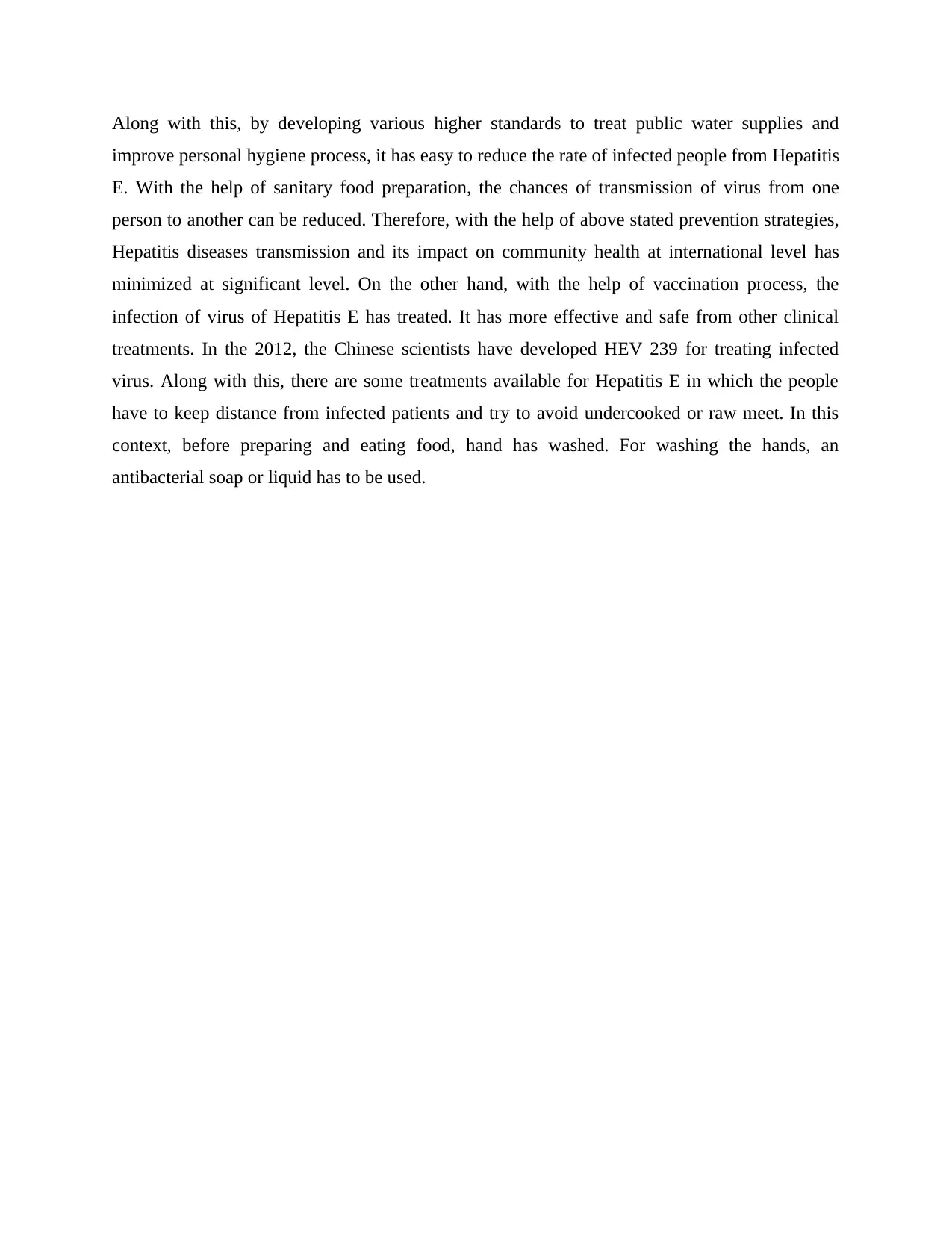
Along with this, by developing various higher standards to treat public water supplies and
improve personal hygiene process, it has easy to reduce the rate of infected people from Hepatitis
E. With the help of sanitary food preparation, the chances of transmission of virus from one
person to another can be reduced. Therefore, with the help of above stated prevention strategies,
Hepatitis diseases transmission and its impact on community health at international level has
minimized at significant level. On the other hand, with the help of vaccination process, the
infection of virus of Hepatitis E has treated. It has more effective and safe from other clinical
treatments. In the 2012, the Chinese scientists have developed HEV 239 for treating infected
virus. Along with this, there are some treatments available for Hepatitis E in which the people
have to keep distance from infected patients and try to avoid undercooked or raw meet. In this
context, before preparing and eating food, hand has washed. For washing the hands, an
antibacterial soap or liquid has to be used.
improve personal hygiene process, it has easy to reduce the rate of infected people from Hepatitis
E. With the help of sanitary food preparation, the chances of transmission of virus from one
person to another can be reduced. Therefore, with the help of above stated prevention strategies,
Hepatitis diseases transmission and its impact on community health at international level has
minimized at significant level. On the other hand, with the help of vaccination process, the
infection of virus of Hepatitis E has treated. It has more effective and safe from other clinical
treatments. In the 2012, the Chinese scientists have developed HEV 239 for treating infected
virus. Along with this, there are some treatments available for Hepatitis E in which the people
have to keep distance from infected patients and try to avoid undercooked or raw meet. In this
context, before preparing and eating food, hand has washed. For washing the hands, an
antibacterial soap or liquid has to be used.
⊘ This is a preview!⊘
Do you want full access?
Subscribe today to unlock all pages.

Trusted by 1+ million students worldwide
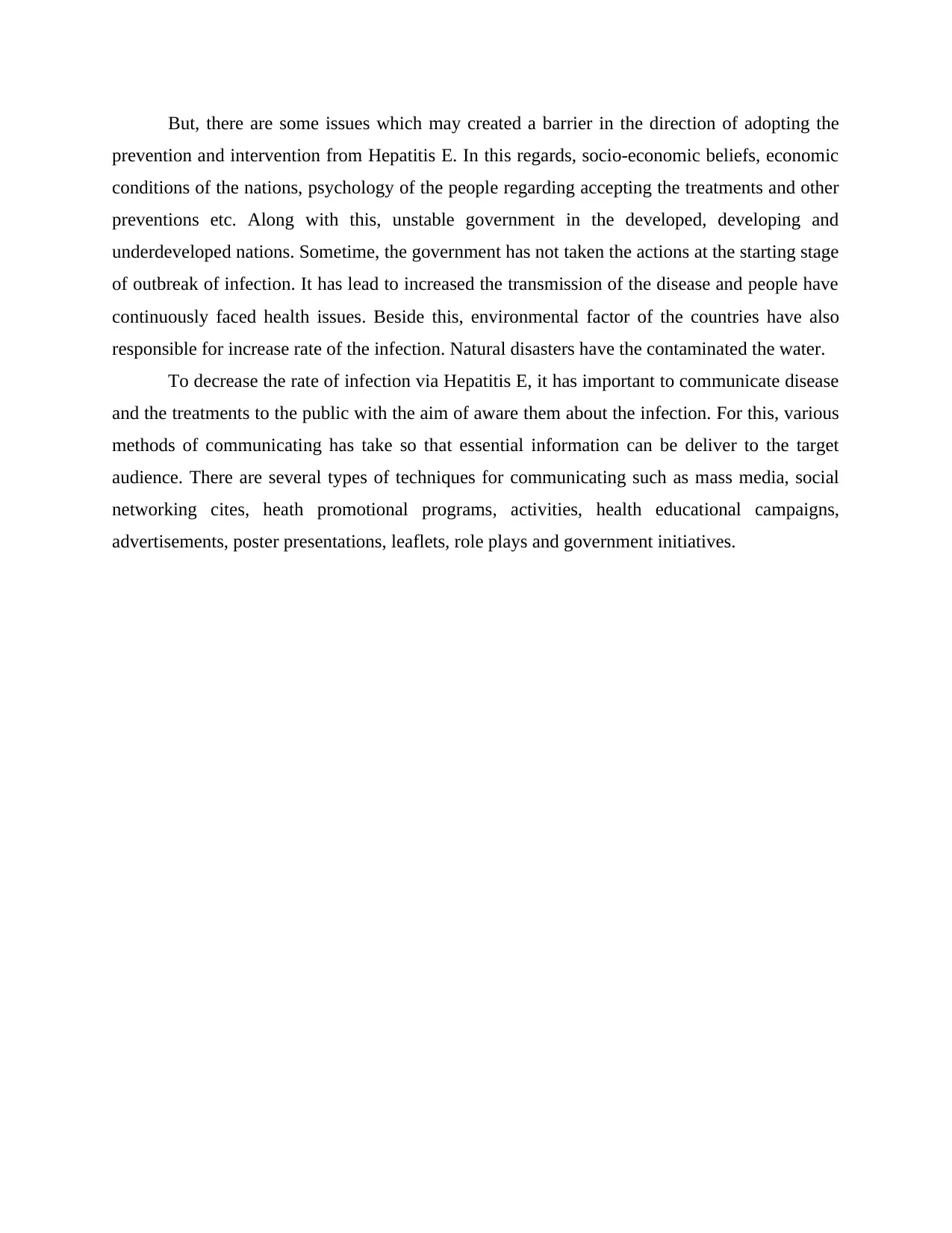
But, there are some issues which may created a barrier in the direction of adopting the
prevention and intervention from Hepatitis E. In this regards, socio-economic beliefs, economic
conditions of the nations, psychology of the people regarding accepting the treatments and other
preventions etc. Along with this, unstable government in the developed, developing and
underdeveloped nations. Sometime, the government has not taken the actions at the starting stage
of outbreak of infection. It has lead to increased the transmission of the disease and people have
continuously faced health issues. Beside this, environmental factor of the countries have also
responsible for increase rate of the infection. Natural disasters have the contaminated the water.
To decrease the rate of infection via Hepatitis E, it has important to communicate disease
and the treatments to the public with the aim of aware them about the infection. For this, various
methods of communicating has take so that essential information can be deliver to the target
audience. There are several types of techniques for communicating such as mass media, social
networking cites, heath promotional programs, activities, health educational campaigns,
advertisements, poster presentations, leaflets, role plays and government initiatives.
prevention and intervention from Hepatitis E. In this regards, socio-economic beliefs, economic
conditions of the nations, psychology of the people regarding accepting the treatments and other
preventions etc. Along with this, unstable government in the developed, developing and
underdeveloped nations. Sometime, the government has not taken the actions at the starting stage
of outbreak of infection. It has lead to increased the transmission of the disease and people have
continuously faced health issues. Beside this, environmental factor of the countries have also
responsible for increase rate of the infection. Natural disasters have the contaminated the water.
To decrease the rate of infection via Hepatitis E, it has important to communicate disease
and the treatments to the public with the aim of aware them about the infection. For this, various
methods of communicating has take so that essential information can be deliver to the target
audience. There are several types of techniques for communicating such as mass media, social
networking cites, heath promotional programs, activities, health educational campaigns,
advertisements, poster presentations, leaflets, role plays and government initiatives.
Paraphrase This Document
Need a fresh take? Get an instant paraphrase of this document with our AI Paraphraser

Table of Contents
EXECUTIVE SUMMARY.............................................................................................................2
INTRODUCTION...........................................................................................................................5
History of Hepatitis E.............................................................................................................6
Reasons for an intervention being required............................................................................9
Issues around sustainability and resilience...........................................................................11
The science behind the hepatitis E vaccines.........................................................................13
Delivering the information for the chosen audience ...........................................................15
CONCLUSION .............................................................................................................................17
REFERENCES................................................................................................................................2
EXECUTIVE SUMMARY.............................................................................................................2
INTRODUCTION...........................................................................................................................5
History of Hepatitis E.............................................................................................................6
Reasons for an intervention being required............................................................................9
Issues around sustainability and resilience...........................................................................11
The science behind the hepatitis E vaccines.........................................................................13
Delivering the information for the chosen audience ...........................................................15
CONCLUSION .............................................................................................................................17
REFERENCES................................................................................................................................2
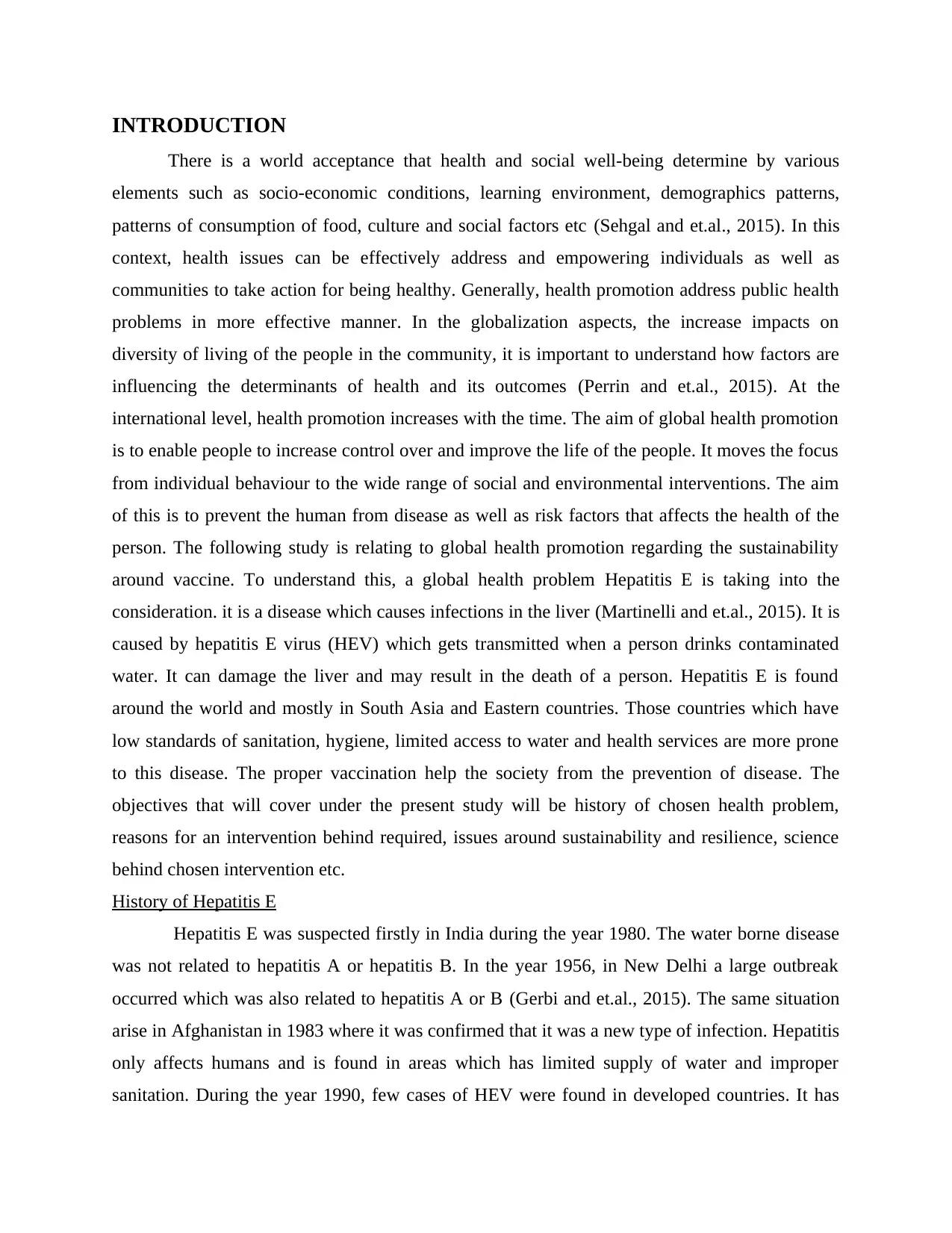
INTRODUCTION
There is a world acceptance that health and social well-being determine by various
elements such as socio-economic conditions, learning environment, demographics patterns,
patterns of consumption of food, culture and social factors etc (Sehgal and et.al., 2015). In this
context, health issues can be effectively address and empowering individuals as well as
communities to take action for being healthy. Generally, health promotion address public health
problems in more effective manner. In the globalization aspects, the increase impacts on
diversity of living of the people in the community, it is important to understand how factors are
influencing the determinants of health and its outcomes (Perrin and et.al., 2015). At the
international level, health promotion increases with the time. The aim of global health promotion
is to enable people to increase control over and improve the life of the people. It moves the focus
from individual behaviour to the wide range of social and environmental interventions. The aim
of this is to prevent the human from disease as well as risk factors that affects the health of the
person. The following study is relating to global health promotion regarding the sustainability
around vaccine. To understand this, a global health problem Hepatitis E is taking into the
consideration. it is a disease which causes infections in the liver (Martinelli and et.al., 2015). It is
caused by hepatitis E virus (HEV) which gets transmitted when a person drinks contaminated
water. It can damage the liver and may result in the death of a person. Hepatitis E is found
around the world and mostly in South Asia and Eastern countries. Those countries which have
low standards of sanitation, hygiene, limited access to water and health services are more prone
to this disease. The proper vaccination help the society from the prevention of disease. The
objectives that will cover under the present study will be history of chosen health problem,
reasons for an intervention behind required, issues around sustainability and resilience, science
behind chosen intervention etc.
History of Hepatitis E
Hepatitis E was suspected firstly in India during the year 1980. The water borne disease
was not related to hepatitis A or hepatitis B. In the year 1956, in New Delhi a large outbreak
occurred which was also related to hepatitis A or B (Gerbi and et.al., 2015). The same situation
arise in Afghanistan in 1983 where it was confirmed that it was a new type of infection. Hepatitis
only affects humans and is found in areas which has limited supply of water and improper
sanitation. During the year 1990, few cases of HEV were found in developed countries. It has
There is a world acceptance that health and social well-being determine by various
elements such as socio-economic conditions, learning environment, demographics patterns,
patterns of consumption of food, culture and social factors etc (Sehgal and et.al., 2015). In this
context, health issues can be effectively address and empowering individuals as well as
communities to take action for being healthy. Generally, health promotion address public health
problems in more effective manner. In the globalization aspects, the increase impacts on
diversity of living of the people in the community, it is important to understand how factors are
influencing the determinants of health and its outcomes (Perrin and et.al., 2015). At the
international level, health promotion increases with the time. The aim of global health promotion
is to enable people to increase control over and improve the life of the people. It moves the focus
from individual behaviour to the wide range of social and environmental interventions. The aim
of this is to prevent the human from disease as well as risk factors that affects the health of the
person. The following study is relating to global health promotion regarding the sustainability
around vaccine. To understand this, a global health problem Hepatitis E is taking into the
consideration. it is a disease which causes infections in the liver (Martinelli and et.al., 2015). It is
caused by hepatitis E virus (HEV) which gets transmitted when a person drinks contaminated
water. It can damage the liver and may result in the death of a person. Hepatitis E is found
around the world and mostly in South Asia and Eastern countries. Those countries which have
low standards of sanitation, hygiene, limited access to water and health services are more prone
to this disease. The proper vaccination help the society from the prevention of disease. The
objectives that will cover under the present study will be history of chosen health problem,
reasons for an intervention behind required, issues around sustainability and resilience, science
behind chosen intervention etc.
History of Hepatitis E
Hepatitis E was suspected firstly in India during the year 1980. The water borne disease
was not related to hepatitis A or hepatitis B. In the year 1956, in New Delhi a large outbreak
occurred which was also related to hepatitis A or B (Gerbi and et.al., 2015). The same situation
arise in Afghanistan in 1983 where it was confirmed that it was a new type of infection. Hepatitis
only affects humans and is found in areas which has limited supply of water and improper
sanitation. During the year 1990, few cases of HEV were found in developed countries. It has
⊘ This is a preview!⊘
Do you want full access?
Subscribe today to unlock all pages.

Trusted by 1+ million students worldwide

been a major health problem in many countries. The first outbreak of HEV in India reported
29,300 cases. Similarly, in China more than 119,000 cases of HEV were found. It has been
divided into four types. Genotypes 1 and 2 are found in humans while genotype 3 and 4 are
found in animals (Kuniholm and et.al., 2015). The HEV in developing countries has been
genotype 1, in Mexico and western Africa has genotype 2 and in Asia it is genotype 4. It has
been the most common cause during the pregnancy. It has accounted for about 37% of acute
viral hepatitis cases. It is still unknown why it causes severe problem in women at the time of
pregnancy. Genotype 1 is considered as a water-borne disease. In India the water bodies are
contaminated by sheep, swine, buffalo and goats. It has given rise to genotype 1 infection in
India. In Uganda, it was found that hepatitis E has transfer from person to person (Debing and
et.al., 2016). There is high risk of genotype 1 infection to those people who live in areas which
are prone to outbreaks, those who travel to HEV endemicity and in refugee camps. It has been
found that person to person transmission has been constantly increasing in many areas. People
are advised to wash their hands and maintain good hygiene in their houses (Holm and et.al.,
2015). China has been developing a vaccine to cure this disease but still it has not been approved
by FDA. Furthermore, two sub units vaccines have also been developed and they have been
successful in preventing HEV. Some of the measures which can be taken to prevent HEV are
educating people about personal hygiene, proper human feces, drinking boiled water, properly
cooking pig and deer meat (Boni and et.al., 2015).
Table 1: Origination of HEV
Years Location No. of persons
infected
Mode of transmission
1955-56 India 29,300 Water-borne
1978-79 India More than 270 Water-borne
1986 Mexico More than 200 Contaminated well
water
1988-89 Ethiopia More than 750 After monsoon rains
1991 India 79,000 Contaminated river
29,300 cases. Similarly, in China more than 119,000 cases of HEV were found. It has been
divided into four types. Genotypes 1 and 2 are found in humans while genotype 3 and 4 are
found in animals (Kuniholm and et.al., 2015). The HEV in developing countries has been
genotype 1, in Mexico and western Africa has genotype 2 and in Asia it is genotype 4. It has
been the most common cause during the pregnancy. It has accounted for about 37% of acute
viral hepatitis cases. It is still unknown why it causes severe problem in women at the time of
pregnancy. Genotype 1 is considered as a water-borne disease. In India the water bodies are
contaminated by sheep, swine, buffalo and goats. It has given rise to genotype 1 infection in
India. In Uganda, it was found that hepatitis E has transfer from person to person (Debing and
et.al., 2016). There is high risk of genotype 1 infection to those people who live in areas which
are prone to outbreaks, those who travel to HEV endemicity and in refugee camps. It has been
found that person to person transmission has been constantly increasing in many areas. People
are advised to wash their hands and maintain good hygiene in their houses (Holm and et.al.,
2015). China has been developing a vaccine to cure this disease but still it has not been approved
by FDA. Furthermore, two sub units vaccines have also been developed and they have been
successful in preventing HEV. Some of the measures which can be taken to prevent HEV are
educating people about personal hygiene, proper human feces, drinking boiled water, properly
cooking pig and deer meat (Boni and et.al., 2015).
Table 1: Origination of HEV
Years Location No. of persons
infected
Mode of transmission
1955-56 India 29,300 Water-borne
1978-79 India More than 270 Water-borne
1986 Mexico More than 200 Contaminated well
water
1988-89 Ethiopia More than 750 After monsoon rains
1991 India 79,000 Contaminated river
Paraphrase This Document
Need a fresh take? Get an instant paraphrase of this document with our AI Paraphraser
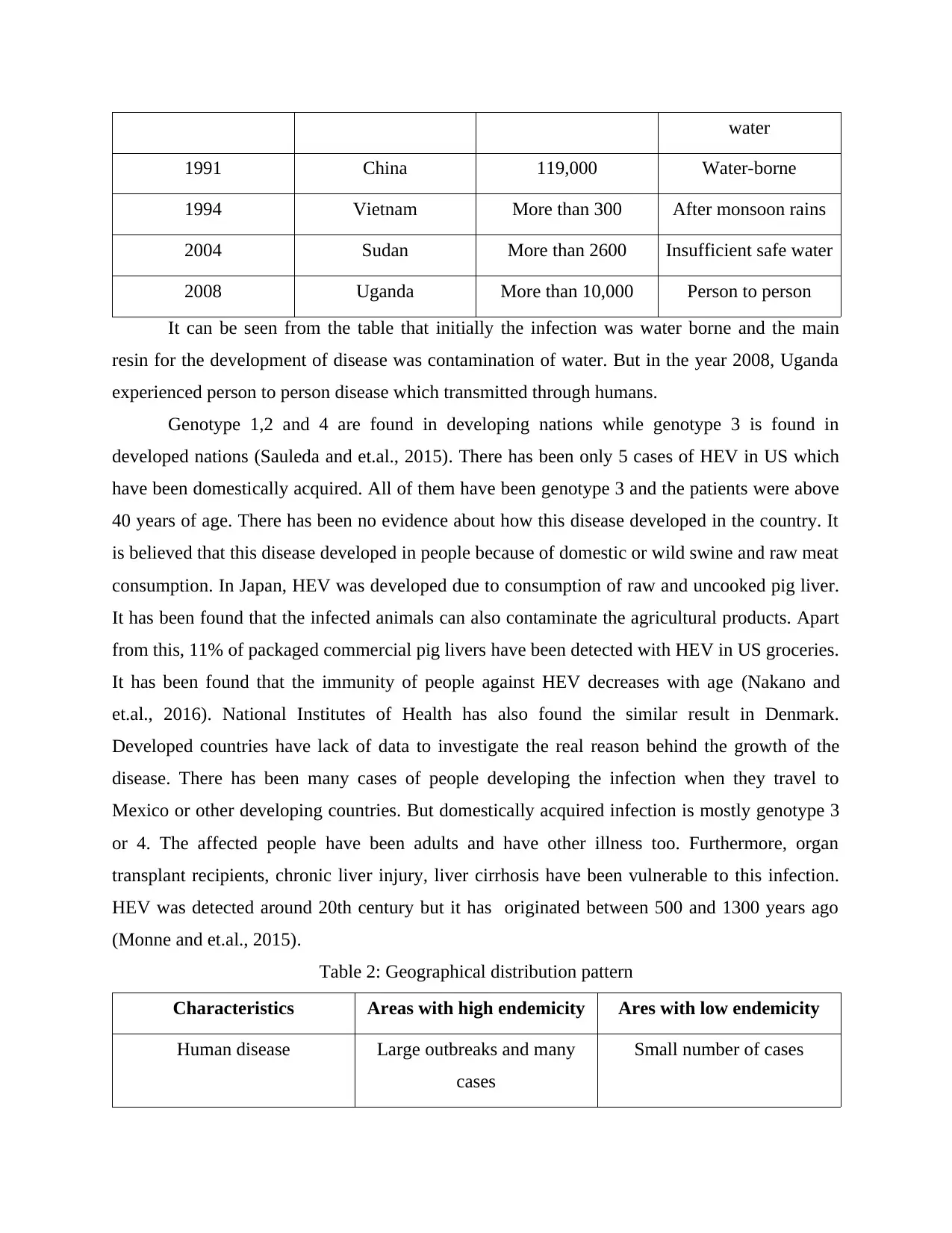
water
1991 China 119,000 Water-borne
1994 Vietnam More than 300 After monsoon rains
2004 Sudan More than 2600 Insufficient safe water
2008 Uganda More than 10,000 Person to person
It can be seen from the table that initially the infection was water borne and the main
resin for the development of disease was contamination of water. But in the year 2008, Uganda
experienced person to person disease which transmitted through humans.
Genotype 1,2 and 4 are found in developing nations while genotype 3 is found in
developed nations (Sauleda and et.al., 2015). There has been only 5 cases of HEV in US which
have been domestically acquired. All of them have been genotype 3 and the patients were above
40 years of age. There has been no evidence about how this disease developed in the country. It
is believed that this disease developed in people because of domestic or wild swine and raw meat
consumption. In Japan, HEV was developed due to consumption of raw and uncooked pig liver.
It has been found that the infected animals can also contaminate the agricultural products. Apart
from this, 11% of packaged commercial pig livers have been detected with HEV in US groceries.
It has been found that the immunity of people against HEV decreases with age (Nakano and
et.al., 2016). National Institutes of Health has also found the similar result in Denmark.
Developed countries have lack of data to investigate the real reason behind the growth of the
disease. There has been many cases of people developing the infection when they travel to
Mexico or other developing countries. But domestically acquired infection is mostly genotype 3
or 4. The affected people have been adults and have other illness too. Furthermore, organ
transplant recipients, chronic liver injury, liver cirrhosis have been vulnerable to this infection.
HEV was detected around 20th century but it has originated between 500 and 1300 years ago
(Monne and et.al., 2015).
Table 2: Geographical distribution pattern
Characteristics Areas with high endemicity Ares with low endemicity
Human disease Large outbreaks and many
cases
Small number of cases
1991 China 119,000 Water-borne
1994 Vietnam More than 300 After monsoon rains
2004 Sudan More than 2600 Insufficient safe water
2008 Uganda More than 10,000 Person to person
It can be seen from the table that initially the infection was water borne and the main
resin for the development of disease was contamination of water. But in the year 2008, Uganda
experienced person to person disease which transmitted through humans.
Genotype 1,2 and 4 are found in developing nations while genotype 3 is found in
developed nations (Sauleda and et.al., 2015). There has been only 5 cases of HEV in US which
have been domestically acquired. All of them have been genotype 3 and the patients were above
40 years of age. There has been no evidence about how this disease developed in the country. It
is believed that this disease developed in people because of domestic or wild swine and raw meat
consumption. In Japan, HEV was developed due to consumption of raw and uncooked pig liver.
It has been found that the infected animals can also contaminate the agricultural products. Apart
from this, 11% of packaged commercial pig livers have been detected with HEV in US groceries.
It has been found that the immunity of people against HEV decreases with age (Nakano and
et.al., 2016). National Institutes of Health has also found the similar result in Denmark.
Developed countries have lack of data to investigate the real reason behind the growth of the
disease. There has been many cases of people developing the infection when they travel to
Mexico or other developing countries. But domestically acquired infection is mostly genotype 3
or 4. The affected people have been adults and have other illness too. Furthermore, organ
transplant recipients, chronic liver injury, liver cirrhosis have been vulnerable to this infection.
HEV was detected around 20th century but it has originated between 500 and 1300 years ago
(Monne and et.al., 2015).
Table 2: Geographical distribution pattern
Characteristics Areas with high endemicity Ares with low endemicity
Human disease Large outbreaks and many
cases
Small number of cases

Characteristics of a diseased
person
Young
More males than females
Mostly old people with other
diseases.
Prevalent causative Viral
genotypes
Genotype 1 and 2 and some
cases of Genotype 4 in China
Genotype 3 and 4.
Reservoir of infection Human Mostly animals like pigs, deer,
wild boars.
Route of transmission Fecal and oral
Mostly form contamination of
water
Intake of raw and uncooked
food
Close contact with infected
animals
Relationship with pregnancy High risk from pregnant
women.
No reports have been found for
women with severe HEV
Chronic infection No reports of Chronic
infection of hepatitis E.
Chronic infection of hepatitis
E have been reported among
people who had organ
transplant and are receiving
immunosuppresive drugs.
The epidemiologic has been seen primarily in Indian subcontinent, Central and South-
east Asia, Middle East and northern parts of Africa (Zhang and et.al., 2015). Large outbreaks
have been reported in China in the year 1980 and 1990. On the other hand, no reports have been
found in America. In the year 1986-87 two small outbreaks were reported in Mexico. HEV has
higher mortality rate among pregnant women and it increases with semester.
Reasons for an intervention being required
Hepatitis E is a major public health concerns in international level. The high prevalence
of this disease worldwide and the significance of its complications, impact of economic and
social raised concern related to global interventions (Lei and et.al., 2016). Hepatitis E is liver
disease which cause by the Hepatitis E virus. The structure of this virus is a non-enveloped and
single stranded ribonucleic acid (RNA) virus. It is transmitted via drinking of contaminated
person
Young
More males than females
Mostly old people with other
diseases.
Prevalent causative Viral
genotypes
Genotype 1 and 2 and some
cases of Genotype 4 in China
Genotype 3 and 4.
Reservoir of infection Human Mostly animals like pigs, deer,
wild boars.
Route of transmission Fecal and oral
Mostly form contamination of
water
Intake of raw and uncooked
food
Close contact with infected
animals
Relationship with pregnancy High risk from pregnant
women.
No reports have been found for
women with severe HEV
Chronic infection No reports of Chronic
infection of hepatitis E.
Chronic infection of hepatitis
E have been reported among
people who had organ
transplant and are receiving
immunosuppresive drugs.
The epidemiologic has been seen primarily in Indian subcontinent, Central and South-
east Asia, Middle East and northern parts of Africa (Zhang and et.al., 2015). Large outbreaks
have been reported in China in the year 1980 and 1990. On the other hand, no reports have been
found in America. In the year 1986-87 two small outbreaks were reported in Mexico. HEV has
higher mortality rate among pregnant women and it increases with semester.
Reasons for an intervention being required
Hepatitis E is a major public health concerns in international level. The high prevalence
of this disease worldwide and the significance of its complications, impact of economic and
social raised concern related to global interventions (Lei and et.al., 2016). Hepatitis E is liver
disease which cause by the Hepatitis E virus. The structure of this virus is a non-enveloped and
single stranded ribonucleic acid (RNA) virus. It is transmitted via drinking of contaminated
⊘ This is a preview!⊘
Do you want full access?
Subscribe today to unlock all pages.

Trusted by 1+ million students worldwide

water. Usually, it is a self confining infection and resolves within 4 to 6 weeks. But, if the virus
develop in the from of hepatitis that create failure of liver. In the recent years, Hepatitis E still
place a major issue for healthcare organization where individual looking for the treatment as well
as care in both normal and complication cases (Rendon and et.al., 2016). So, it is require to plan
for appropriate intervention and arrange proper resources and it will leads to easily quantified the
number of patients and their level of seriousness of diseases (Smith and et.al., 2015).
Outbreak of Hepatitis E occur around the world and these are quickly happening in under
developed nations or limited resources countries. In such places, the people have limited access
water, poor facilities of sanitation, unhygienic places and lack health services. These all reasons
have affected the health of the people. From the past evidence (Di Bartolo and et.al., 2015), it has
found that in recent years, some outbreak of Hepatitis E has occurred in areas such as
humanitarian emergencies in war zones, in the camp of refugees, internally displaced
populations etc. Along with this, it has also determined that in these locations, 20 million people
infected and 3.3 million cases occur related to this disease in the world and 56000 people died
from Hepatitis E (Koning. and et.al., 2015).
There are various genotype of Hepatitis E virus because of differences in epidemiology.
Genotype 1 is mainly seen in developing nations and occur outbreaks at community level. But
genotype 3 of Hepatitis E can be seen in the developed countries but does not create any kind of
outbreaks. Seroprevalence rates high in those geographical locations where standards of
sanitation is low and it causes a risk of transmission of Hepatitis E virus. South and East Asia are
come under the most infected locations because of this disease (Deng, Cho,Fiers and Saelens,
2015). The frequent outbreak can be seen in both the countries at the time of rainy season when
sources of water become contaminated by faecal materials. So, by drinking faecal contaminated
water, the virus of Hepatitis E transmitted into the human body. On the other hand, there are
many other ways by which the disease can be transmitted into the person.
Sometimes, Hepatitis E creates other diseases like diabetes, prior liver diseases and
cardiovascular issue (Becattini and et.al., 2015). In this context, from the research, it has found
that in UK, the following disease on peaks in spring and summer seasons. Along with this, it has
appeared in coastal and estuarine areas. Seropidemiological data shows that in 1988-1994, the
rate of Hepatitis E in US was 21% and it was increasing with the time. In 1955-156, the number
of infected persons form virus was 29300 and in 1991, these number was increasing and reach at
develop in the from of hepatitis that create failure of liver. In the recent years, Hepatitis E still
place a major issue for healthcare organization where individual looking for the treatment as well
as care in both normal and complication cases (Rendon and et.al., 2016). So, it is require to plan
for appropriate intervention and arrange proper resources and it will leads to easily quantified the
number of patients and their level of seriousness of diseases (Smith and et.al., 2015).
Outbreak of Hepatitis E occur around the world and these are quickly happening in under
developed nations or limited resources countries. In such places, the people have limited access
water, poor facilities of sanitation, unhygienic places and lack health services. These all reasons
have affected the health of the people. From the past evidence (Di Bartolo and et.al., 2015), it has
found that in recent years, some outbreak of Hepatitis E has occurred in areas such as
humanitarian emergencies in war zones, in the camp of refugees, internally displaced
populations etc. Along with this, it has also determined that in these locations, 20 million people
infected and 3.3 million cases occur related to this disease in the world and 56000 people died
from Hepatitis E (Koning. and et.al., 2015).
There are various genotype of Hepatitis E virus because of differences in epidemiology.
Genotype 1 is mainly seen in developing nations and occur outbreaks at community level. But
genotype 3 of Hepatitis E can be seen in the developed countries but does not create any kind of
outbreaks. Seroprevalence rates high in those geographical locations where standards of
sanitation is low and it causes a risk of transmission of Hepatitis E virus. South and East Asia are
come under the most infected locations because of this disease (Deng, Cho,Fiers and Saelens,
2015). The frequent outbreak can be seen in both the countries at the time of rainy season when
sources of water become contaminated by faecal materials. So, by drinking faecal contaminated
water, the virus of Hepatitis E transmitted into the human body. On the other hand, there are
many other ways by which the disease can be transmitted into the person.
Sometimes, Hepatitis E creates other diseases like diabetes, prior liver diseases and
cardiovascular issue (Becattini and et.al., 2015). In this context, from the research, it has found
that in UK, the following disease on peaks in spring and summer seasons. Along with this, it has
appeared in coastal and estuarine areas. Seropidemiological data shows that in 1988-1994, the
rate of Hepatitis E in US was 21% and it was increasing with the time. In 1955-156, the number
of infected persons form virus was 29300 and in 1991, these number was increasing and reach at
Paraphrase This Document
Need a fresh take? Get an instant paraphrase of this document with our AI Paraphraser
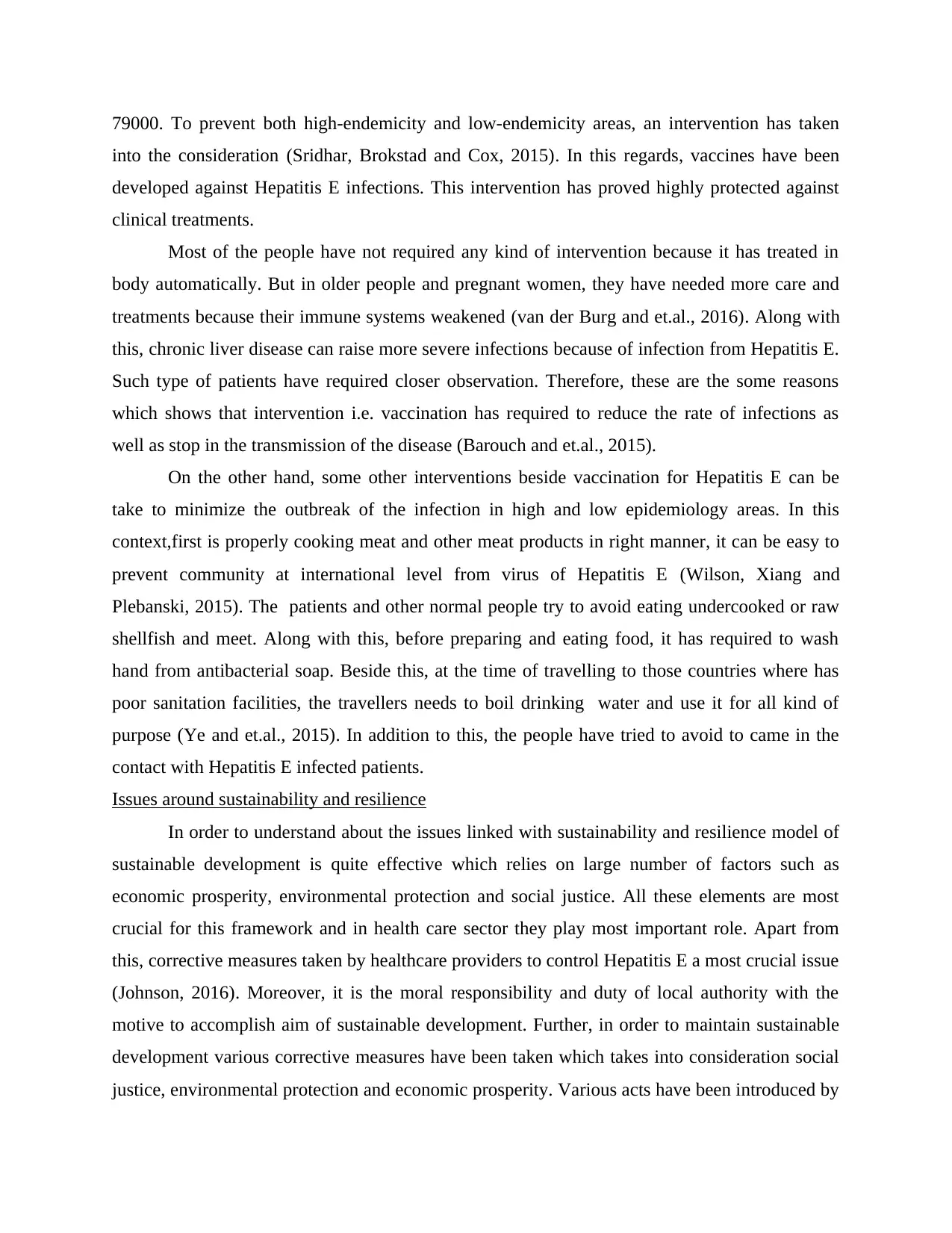
79000. To prevent both high-endemicity and low-endemicity areas, an intervention has taken
into the consideration (Sridhar, Brokstad and Cox, 2015). In this regards, vaccines have been
developed against Hepatitis E infections. This intervention has proved highly protected against
clinical treatments.
Most of the people have not required any kind of intervention because it has treated in
body automatically. But in older people and pregnant women, they have needed more care and
treatments because their immune systems weakened (van der Burg and et.al., 2016). Along with
this, chronic liver disease can raise more severe infections because of infection from Hepatitis E.
Such type of patients have required closer observation. Therefore, these are the some reasons
which shows that intervention i.e. vaccination has required to reduce the rate of infections as
well as stop in the transmission of the disease (Barouch and et.al., 2015).
On the other hand, some other interventions beside vaccination for Hepatitis E can be
take to minimize the outbreak of the infection in high and low epidemiology areas. In this
context,first is properly cooking meat and other meat products in right manner, it can be easy to
prevent community at international level from virus of Hepatitis E (Wilson, Xiang and
Plebanski, 2015). The patients and other normal people try to avoid eating undercooked or raw
shellfish and meet. Along with this, before preparing and eating food, it has required to wash
hand from antibacterial soap. Beside this, at the time of travelling to those countries where has
poor sanitation facilities, the travellers needs to boil drinking water and use it for all kind of
purpose (Ye and et.al., 2015). In addition to this, the people have tried to avoid to came in the
contact with Hepatitis E infected patients.
Issues around sustainability and resilience
In order to understand about the issues linked with sustainability and resilience model of
sustainable development is quite effective which relies on large number of factors such as
economic prosperity, environmental protection and social justice. All these elements are most
crucial for this framework and in health care sector they play most important role. Apart from
this, corrective measures taken by healthcare providers to control Hepatitis E a most crucial issue
(Johnson, 2016). Moreover, it is the moral responsibility and duty of local authority with the
motive to accomplish aim of sustainable development. Further, in order to maintain sustainable
development various corrective measures have been taken which takes into consideration social
justice, environmental protection and economic prosperity. Various acts have been introduced by
into the consideration (Sridhar, Brokstad and Cox, 2015). In this regards, vaccines have been
developed against Hepatitis E infections. This intervention has proved highly protected against
clinical treatments.
Most of the people have not required any kind of intervention because it has treated in
body automatically. But in older people and pregnant women, they have needed more care and
treatments because their immune systems weakened (van der Burg and et.al., 2016). Along with
this, chronic liver disease can raise more severe infections because of infection from Hepatitis E.
Such type of patients have required closer observation. Therefore, these are the some reasons
which shows that intervention i.e. vaccination has required to reduce the rate of infections as
well as stop in the transmission of the disease (Barouch and et.al., 2015).
On the other hand, some other interventions beside vaccination for Hepatitis E can be
take to minimize the outbreak of the infection in high and low epidemiology areas. In this
context,first is properly cooking meat and other meat products in right manner, it can be easy to
prevent community at international level from virus of Hepatitis E (Wilson, Xiang and
Plebanski, 2015). The patients and other normal people try to avoid eating undercooked or raw
shellfish and meet. Along with this, before preparing and eating food, it has required to wash
hand from antibacterial soap. Beside this, at the time of travelling to those countries where has
poor sanitation facilities, the travellers needs to boil drinking water and use it for all kind of
purpose (Ye and et.al., 2015). In addition to this, the people have tried to avoid to came in the
contact with Hepatitis E infected patients.
Issues around sustainability and resilience
In order to understand about the issues linked with sustainability and resilience model of
sustainable development is quite effective which relies on large number of factors such as
economic prosperity, environmental protection and social justice. All these elements are most
crucial for this framework and in health care sector they play most important role. Apart from
this, corrective measures taken by healthcare providers to control Hepatitis E a most crucial issue
(Johnson, 2016). Moreover, it is the moral responsibility and duty of local authority with the
motive to accomplish aim of sustainable development. Further, in order to maintain sustainable
development various corrective measures have been taken which takes into consideration social
justice, environmental protection and economic prosperity. Various acts have been introduced by
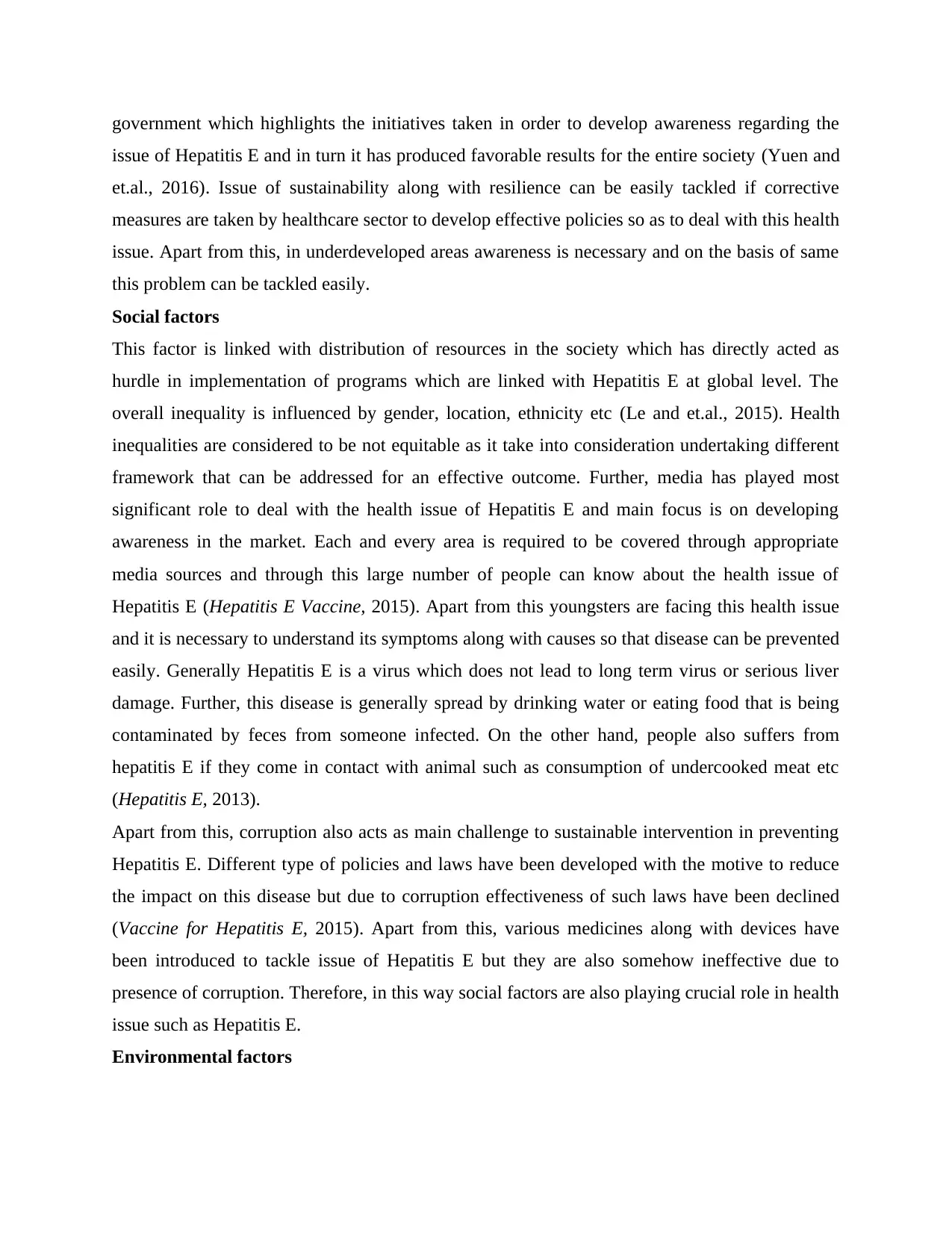
government which highlights the initiatives taken in order to develop awareness regarding the
issue of Hepatitis E and in turn it has produced favorable results for the entire society (Yuen and
et.al., 2016). Issue of sustainability along with resilience can be easily tackled if corrective
measures are taken by healthcare sector to develop effective policies so as to deal with this health
issue. Apart from this, in underdeveloped areas awareness is necessary and on the basis of same
this problem can be tackled easily.
Social factors
This factor is linked with distribution of resources in the society which has directly acted as
hurdle in implementation of programs which are linked with Hepatitis E at global level. The
overall inequality is influenced by gender, location, ethnicity etc (Le and et.al., 2015). Health
inequalities are considered to be not equitable as it take into consideration undertaking different
framework that can be addressed for an effective outcome. Further, media has played most
significant role to deal with the health issue of Hepatitis E and main focus is on developing
awareness in the market. Each and every area is required to be covered through appropriate
media sources and through this large number of people can know about the health issue of
Hepatitis E (Hepatitis E Vaccine, 2015). Apart from this youngsters are facing this health issue
and it is necessary to understand its symptoms along with causes so that disease can be prevented
easily. Generally Hepatitis E is a virus which does not lead to long term virus or serious liver
damage. Further, this disease is generally spread by drinking water or eating food that is being
contaminated by feces from someone infected. On the other hand, people also suffers from
hepatitis E if they come in contact with animal such as consumption of undercooked meat etc
(Hepatitis E, 2013).
Apart from this, corruption also acts as main challenge to sustainable intervention in preventing
Hepatitis E. Different type of policies and laws have been developed with the motive to reduce
the impact on this disease but due to corruption effectiveness of such laws have been declined
(Vaccine for Hepatitis E, 2015). Apart from this, various medicines along with devices have
been introduced to tackle issue of Hepatitis E but they are also somehow ineffective due to
presence of corruption. Therefore, in this way social factors are also playing crucial role in health
issue such as Hepatitis E.
Environmental factors
issue of Hepatitis E and in turn it has produced favorable results for the entire society (Yuen and
et.al., 2016). Issue of sustainability along with resilience can be easily tackled if corrective
measures are taken by healthcare sector to develop effective policies so as to deal with this health
issue. Apart from this, in underdeveloped areas awareness is necessary and on the basis of same
this problem can be tackled easily.
Social factors
This factor is linked with distribution of resources in the society which has directly acted as
hurdle in implementation of programs which are linked with Hepatitis E at global level. The
overall inequality is influenced by gender, location, ethnicity etc (Le and et.al., 2015). Health
inequalities are considered to be not equitable as it take into consideration undertaking different
framework that can be addressed for an effective outcome. Further, media has played most
significant role to deal with the health issue of Hepatitis E and main focus is on developing
awareness in the market. Each and every area is required to be covered through appropriate
media sources and through this large number of people can know about the health issue of
Hepatitis E (Hepatitis E Vaccine, 2015). Apart from this youngsters are facing this health issue
and it is necessary to understand its symptoms along with causes so that disease can be prevented
easily. Generally Hepatitis E is a virus which does not lead to long term virus or serious liver
damage. Further, this disease is generally spread by drinking water or eating food that is being
contaminated by feces from someone infected. On the other hand, people also suffers from
hepatitis E if they come in contact with animal such as consumption of undercooked meat etc
(Hepatitis E, 2013).
Apart from this, corruption also acts as main challenge to sustainable intervention in preventing
Hepatitis E. Different type of policies and laws have been developed with the motive to reduce
the impact on this disease but due to corruption effectiveness of such laws have been declined
(Vaccine for Hepatitis E, 2015). Apart from this, various medicines along with devices have
been introduced to tackle issue of Hepatitis E but they are also somehow ineffective due to
presence of corruption. Therefore, in this way social factors are also playing crucial role in health
issue such as Hepatitis E.
Environmental factors
⊘ This is a preview!⊘
Do you want full access?
Subscribe today to unlock all pages.

Trusted by 1+ million students worldwide
1 out of 21
Related Documents
Your All-in-One AI-Powered Toolkit for Academic Success.
+13062052269
info@desklib.com
Available 24*7 on WhatsApp / Email
![[object Object]](/_next/static/media/star-bottom.7253800d.svg)
Unlock your academic potential
Copyright © 2020–2025 A2Z Services. All Rights Reserved. Developed and managed by ZUCOL.





